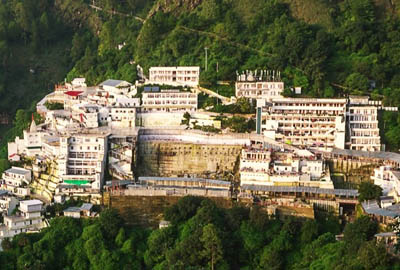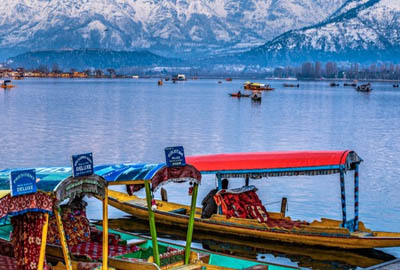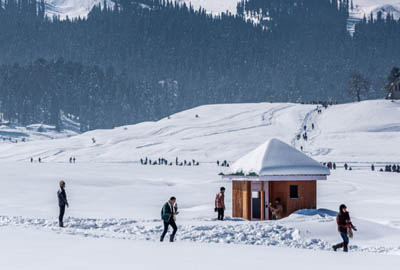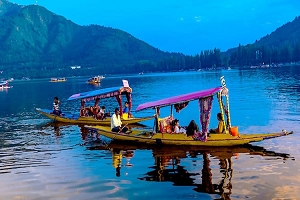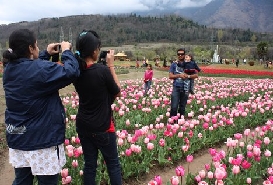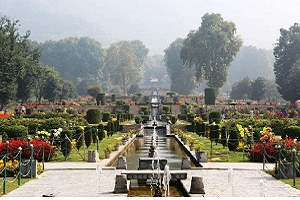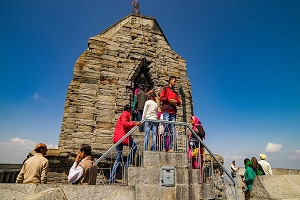Kashmir is known for its snowfall, and people are often enticed to see the thick snow-covered region of Kashmir. If you want to see it too, plan your trip in December and January and enjoy a fun-filled vacation in the snowy paradise. Winter is the best time to enjoy snowfall in Kashmir and behold the mesmerizing sight of scenic valleys. And if you are thinking about the best place to enjoy snow activities in Kashmir, Gulmarg tops the list. It is India’s top skiing destination. Kashmir experiences snowfall from December to March, so this is the best time to visit Kashmir for those who want to experience a flurry of snowflakes.
Explore Kashmir tour pacakge for 5 nights
Temperature during Snowfall in Kashmir
The snow can lead to a dip in the Kashmir temperature. It can go from 4°C to straight -2°C. So, make sure you carry the proper winter gear. Honeymooners and adventure lovers have the chance to enjoy Kashmir snowfall, cold weather, and hot chocolate during this time. Couples can indulge in romantic experiences and adventures and can enjoy skiing, snowboarding, trekking, and more exciting activities.
Keep reading to know more about snowfall in Kashmir each winter month –
Snowfall in Kashmir in Decenber
December is the month when the snow starts pouring in Kashmir. The average temperature during December in Kashmir remains around 2.8°C, making it extremely cold. For snowfall, Srinagar, Harissa, and Pahalgam are some of the best places to visit in Kashmir.
Honeymooners can enjoy sightseeing tours and romantic dates and enjoy hot chocolate to avoid getting sick. For a memorable time in Kashmir in December, you can enjoy cable car rides, winter delicacies, and pony rides.
Remember to avoid visiting Sonamarg as the roads from Srinagar to Sonamarg get closed and do not open till March.
Snowfall in Kashmir in January
January is the coldest month in Kashmir. The temperatures can be at -4°C during the day and get as low as -15°C at night. Kashmir has a 40 days short winter period, also called ‘Chillai Kalan,’ of which January is a significant part. In January, you can see a thick layer of snow and frequent snowfall in Kashmir.
There are some cons to visiting Kashmir during this time. First, be prepared for flight delays due to bad and extreme weather conditions. You may also find blocked roads to Gulmarg, but they have clearing machines, so that will not be a problem. But for that, you should have extra time on your hands.
You can easily visit Pahalgam, which does not has such problems. Dal Lake might be frozen due to rough weather, but it is a beautiful sight. For staying in Kashmir in January during snowfall, budget hotels would not be the best idea as they may not provide room heaters and only warmers and blankets. Pick a hotel to stay at in January wisely.
Snowfall in Kashmir in February
February is a great time to visit Kashmir to witness snowfall. However, the thick snow can only be seen during early February, and as the month progresses, snow starts to clear out, blocked roads to Gulmarg and Sonamarg get open, and you can easily reach these places.
You can take a flight, bus, or drive in your car to enjoy this snowy paradise. The average temperature also rises from 0.3°C in January to 2.2°C in February, making the weather more bearable. If you are a non-vegetarian, you are in for a treat as the food will keep you warm. Gulmarg Gondola, skiing, snowboarding, trekking, boat rides, etc., are some fun activities you can enjoy in Kashmir in February.
Check out Jammu and Kashmir Tour Packages, Gulmarg Tour Packages
Snowfall in Kashmir in March
To see snowfall in Kashmir in March, visit Gulmarg. It starts to snow here in December and continues till March. The average temperature also rises to 6.5°C. Don’t visit at the end of March as most of the snow will be gone by that time. For skiing, sledges, and snow-clad slopes, visit Pahalgam and Gulmarg.
If you want to enjoy your Kashmir trip without the cold hindering your travel, March is the best time to visit Kashmir for snow. Srinagar, the summer capital, sees the sun shining brightly; here, you wouldn’t see snow. Dal Lake is also not frozen anymore, and you can enjoy shikara rides. Nishat and Shalimar Garden can be explored for lush greenery and fountains.
Packing Tips
It is crucial to dress according to the weather, especially in Kashmir’s snow season. Wear warm coats and jackets in winter to keep yourself warm. As you probably know now, January is the coldest month, so you must be prepared for the harsh weather conditions and pack your suitcase accordingly. Thermals, heavy jackets, warm socks, muffles, gloves, sunscreen, sunglasses, and more are a must to bring to Kashmir with you.
- Thermals – They are a must as a base layer underneath all your other warm jackets on top. It will keep you warm.
- Full/cut sleeve sweaters – Good for layering on top of your thermal and under your heavy jackets.
- Coats and Jackets – A must in Kashmir. They keep your torso and arms covered and protected from the freezing weather. You can wear leather coats, ski jackets, bomber jackets, pea coats, fur coats, puffer coats, etc.
- Kashmir has traditional wear called ‘Phiran.’ It is a long Kashmiri garment that will extend up to your feet. It is usually made of jamawar, a mix of wool and cotton. It will also provide you with the warmth you need in Kashmir.
Apart from this, here are some must-haves for Kashmir’s snowfall weather –
- Sturdy pair of shoes.
- If you are going on a trek, trekking boots are a must.
- Moisturizers, hand creams, etc.
- Waterproof duffel bags to keep your charges, phones, and other electronics.
- High-temperature water bottle to keep your bed warm.
- Warm cup to enjoy your hot refreshments.
Browse through our Amarnath yatra tour packages from Delhi, Amarnath yatra tour packages from Bangalore, Kashmir tour packages from Chennai



